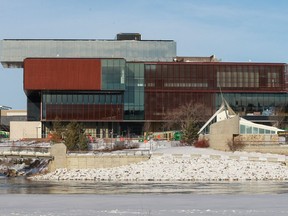Op-Ed: Indigenizing the Remai Modern is important work

Article content
Like most people in the Saskatoon art community, we were thrilled to learn that the Remai Modern Art Gallery of Saskatchewan will be hosting the lone Canadian exhibition of Jimmie Durham: At the Center of the World, in 2018. Durham’s work as an artist, performer, poet, and activist has been a model for Indigenous resistance and self-determination for more than half a century, and he has been an inspiration and teacher to many Canadian and Saskatchewan artists, curators, writers, and activists, both indigenous and non-indigenous.
We were also heartened to learn that Remai CEO and Executive Director, Gregory Burke, plans to make a commitment to make the Remai “a leading centre for contemporary indigenous art.” It is only fitting: Saskatchewan has been a leading centre for contemporary indigenous art for several decades, beginning with the establishment of the Indian Art Program in 1972, led by the legendary Sarain Stump.
Saskatchewan’s achievements include Canada’s first indigenous artist-run centres — TRIBE, Inc., in Saskatoon and Sâkêwêwak Artists’ Collective in Regina, both instrumental in developing the dialogue around indigenous contemporary art for almost 30 years, provincially, nationally, and internationally. Saskatchewan also boasts Edward Poitras, who in 1995 was the first artist of indigenous ancestry to represent Canada at the Venice Biennale.
Indeed, many of Saskatchewan’s best known contemporary artists of all disciplines are indigenous, including visual artists: Joi Arcand, Marjorie Beaucage, Henry Beaudry, Robin Brass, Dana Claxton, Thirza Cuthand, Ruth Cuthand, Wally Dion, Tasha Hubbard, Mary Longman, Neal McLeod, Gerald McMaster, Edward Poitras, Buffy Sainte-Marie, Adrian Stimson, and the late Bob Boyer and Alan Sapp.
However, the indigenous people of Saskatchewan continue to contribute in the face of seemingly endless inequality. The July 29, 2016 cover story in Maclean’s magazine focused on the glaring omission of indigenous people from positions of cultural, academic, and political power in Saskatchewan, a major impediment to social equality and a source of discouragement for indigenous youth, a “glass ceiling” of habitual institutional exclusion.
The Truth and Reconciliation Commission of Canada called upon governments to work with indigenous people to address the employment gap between indigenous and non-indigenous Canadians (StatsCan surveys show that the unemployment rate for Saskatchewan’s First Nation people is five times higher than that of non-indigenous residents). Many publicly funded organizations in Saskatchewan, including the University of Saskatchewan and the University of Regina, have already begun implementing strategies for eliminating these gaps. The City of Saskatoon, in partnership with the Saskatchewan Human Rights Commission, has also set targets for increasing the percentage of indigenous people in its employment.
In Regina, The MacKenzie Art Gallery laid out its intention to become a centre for excellence in contemporary indigenous art several years ago, and employs a full-time curator of indigenous heritage and several contract indigenous story-keepers. In Saskatoon, Wanuskewin Heritage Park hosts a constantly rotating program of exhibitions of contemporary indigenous art from across North America and employs a full-time Cree art historian and curator.
Regardless of the Remai Modern’s specific plans, can we expect the gallery to harness the considerable talents and experience of indigenous artists, curators, and writers living in Saskatchewan?
This is certainly our hope, if only as a means of guaranteeing the success of this new initiative. It is a myth to think that the arts are an effortless source of bridge-building and cultural exchange – they can also be carelessly elitist and contribute to cultural segregation and social injustice. The presence of indigenous staff in positions of influence at the Remai Modern will provide the expertise, judgment and understanding needed to help make this difference.
Jimmie Durham will not be travelling to Saskatoon for his exhibition, but it would be fitting that the lone Canadian institution hosting his retrospective reflect its goodwill towards the indigenous citizens it is established to serve, not just by exhibiting indigenous art, but by employing indigenous people as experts and in positions of leadership.
We look forward to hearing more about the Remai Modern’s plans in the near future.
Jen Budney, PhD Candidate, Johnson Shoyama Graduate School of Public Policy, University of Saskatchewan; former Mendel Art Gallery Associate Curator
Lori Blondeau, Artist and Executive Director of Tribe, Inc.
Jeremy Morgan, arts consultant; former CEO, Wanuskewin Heritage Park






Postmedia is committed to maintaining a lively but civil forum for discussion. Please keep comments relevant and respectful. Comments may take up to an hour to appear on the site. You will receive an email if there is a reply to your comment, an update to a thread you follow or if a user you follow comments. Visit our Community Guidelines for more information.